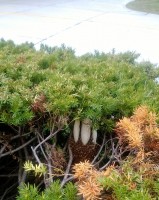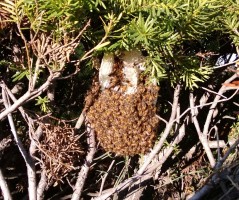By Carol Boshart
Wes and I were doing a routine evening walk around our garden when we peeked into a damaged shrub and were startled to find an active honey bee hive. The bees nearly covered the comb. The next morning in the cold weather half the comb was exposed, but the bees covered most of the comb again in the afternoon sunshine. Unfortunately, we’ll lose that welcome group of pollinators because, unprotected, they won’t withstand the winter. Maybe another swarm will find us next spring!
(Click either image for a larger version)




is it possible that a beekeeper could move the hive to a more secure/warm place for the winter?
Two beekeepers that I have consulted said it would not work at this point.
Wow! Do you think anything you planted was instrumental in attracting them?
I hope so. The natives that I observed were attracting a different type of bee, in abundance! I did notice numerous honey bees in our vegetable garden, particularly on the squash and cucumbers, and in our annual flower beds.
After a rain and two freezing nights in mid November, the hive detached and fell into the branches below. It broke into pieces with most of its valiant, but dead inhabitants, still clinging on to protect the queen.
The two beekeepers we consulted agreed that the hive’s location may have been chosen by a young queen making her first nest. If any of us had noticed it earlier in the summer, the hive could have been moved into a box and the bees allowed to continue to produce honey to sustain themselves over the winter.
A good lesson.